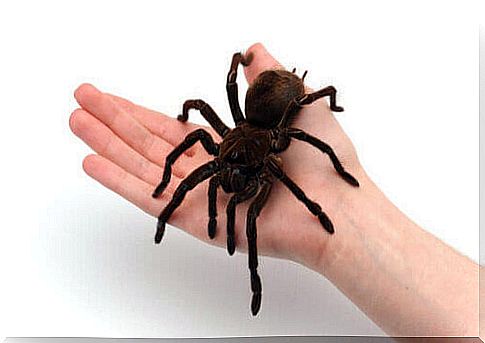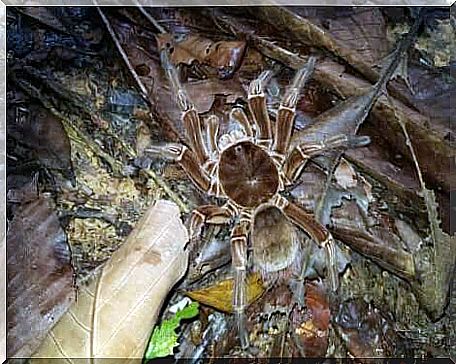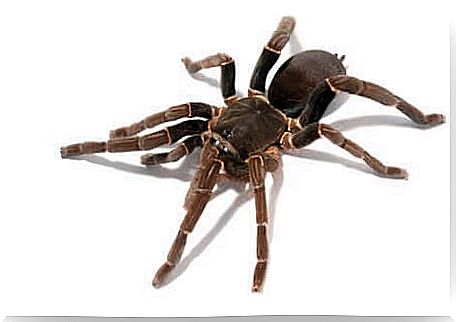Some Curiosities About Giant Tarantulas

Taxonomically, giant tarantulas are part of the Theraphosidae family . This word derives from the Greek and means “beast of light”, even if, curiously, for the most part they are animals with nocturnal habits.
There is no doubt that these huge arthropods have instilled a real terror throughout the history of mankind. Nonetheless, many people decide to keep them as pets. If you watch out for their stinging hair, it might not be such a bizarre idea. We invite you to discover other curiosities about giant tarantulas!
Goliath tarantula: the heaviest
Theraphosa blondi , also known as “goliath tarantula”, is the heaviest tarantula of the entire Theraphosidae family . It can easily reach a weight of 170 grams and can measure more than 30 centimeters in length (including the legs).
Although in English this tarantula receives the nickname of bird-eating spider (“spider eats birds”), the reason for this nickname is due to an ancient engraving of the eighteenth century, in which a spider of another species is devouring a hummingbird. In general, all tarantulas of the genus Theraphosa receive this nickname, although in reality they usually feed on other insects that are smaller than their own.

The curious form of defense of the goliath tarantula
Despite their terrible appearance, giant tarantulas also have predators. In the case of the goliath tarantula, its most important predator is the coati. When a tarantula identifies its presence, it begins to rub its front legs, which are covered with stinging harpoons.
If the predator gets too close, the goliath tarantula quickly opens its paws and throws these stinging hairs, which cause severe irritation and push the predator to flee.
As a further curiosity regarding the goliath tarantula, it should be noted that the latter uses these same harpoons to cover their spawning, which can contain between 50 and 150 eggs.
Once born, the puppies stay with their mother for two or three years, until they reach adulthood. These arthropods are very long-lived: females live 30 years, while males 16.
Giant tarantulas: Theraphosa stirmi
Just like the goliath tarantula, its relative, Theraphosa stirmi , also known as the “bird devourer of Burgundy”, it is capable of reaching a considerable size. In captivity, specimens exceeding 30 centimeters in length have been identified.
Nevertheless, this species is not as heavy as Theraphosa blondi : in fact, on average it reaches only 100 grams of weight, even if there is news of a female who has reached 150 grams, also in captivity.
Theraphosa’s menacing whistles stir me
Even Theraphosa stirmi is one of the giant tarantulas that has the ability to launch their own stinging darts in the direction of the muzzle of his enemies. However, it also has another strategy that it uses to destroy them (or, at least, to try to do so).
When the Burgundy bird-devouring tarantula feels threatened, it emits a very high pitched whistle before attacking, with which it warns the predator that it has spotted it and that it will not hesitate to use its defense weapons.
Giant tarantulas are blind
Unlike other spiders (such as jumping spiders or Salticidae ), giant tarantulas are characterized by being blind. They can see different gradations of light and movement, but their ocelli are very primitive eye structures.
To compensate for this deficiency, they possess a remarkable sense of touch, thanks to their paws and the special hairs present on the paws themselves and below the body. Through these organs, tarantulas can know which prey is in the surrounding area and are able to identify even their size and understand if they are dangerous specimens.
Aquatic skills of giant tarantulas
Within the Theraphosidae family , to which giant tarantulas belong, there is a genus called Hysterocrates , within which we find the species Hysterocrates gigas .
These tarantulas possess the unusual ability to swim and dive. Thanks to this quality, H. gigas is able to catch fish in the water, which complement its varied diet, consisting of insects, micro-mammals and birds.
On the other hand, this group of spiders, although poisonous, are neither lethal nor a real threat to humans (even if a sting is really painful, due to the size of the chelicerae). In addition, they are devoid of stinging hairs, but are much more aggressive than other tarantulas.

Giant tarantulas as pets
Many species of tarantulas live in some homes as pets. Before deciding to take one with you, however, it is good that you inform yourself correctly of all its needs, since it is not a particularly easy arthropod to keep in captivity.
Finally, it must be taken into account that they are not animals that can be touched or caressed : they are rather animals that are collectible. If you think you can’t care for a tarantula properly, but want an exotic pet, it’s best to turn to other species.









